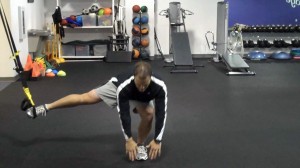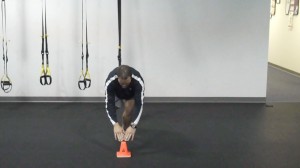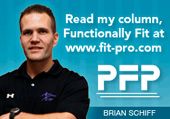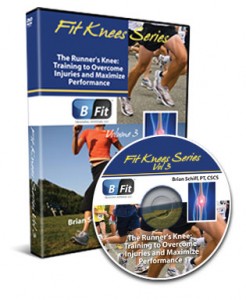Brian Schiff’s Blog
Injury Prevention, Sports Rehab & Performance Training Expert
Core training is common terminology thrown around in fitness circles today. However, not much research has specifically addressed more advanced stability ball exercises and muscle activation until now.
A recent article released in the May 2010 Journal of Orthopedic & Sports Physical Therapy looked at 8 stability ball exercises and maximal voluntary isometric contraction (MVIC) versus traditional bent knee curl ups and crunches.
The 8 stability ball exercises studied with EMG were:
- Roll out
- Pike
- Knee up
- Skier
- Prone hip extension left
- Prone hip extension right
- Decline push-up
- Seated march right

Pike (end position)
All exercises were performed with a cadence of 1/1/1. A metronome was used to ensure uniform repetitions and holds. Researchers concluded that the pike and roll-out were the most effective exercises based on EMG activation. However, keep in mind that these also require the greatest effort and pose a high degree of difficulty.
Why is this stuff important? Research done by Cholecki and VanVliet concluded that no single core muscle can be identified as the most important for spinal stability. Additionally, they believe that the relative importance of the muscle varies based on the direction and magnitude of the load imposed on the spine.
We have known for years the spine is least stable and most vulnerable in trunk flexion (as in the knee bent curl up), and that no one muscle contributes more than 30% to overall spine stability. Choosing more demanding core exercises also typically increases spinal compressive forces as well. This may be contraindicated in some populations.
Therefore knowing your client and condition is essential. For example, flexion is often contraindicated with active disk pathology, whereas it may be indicated in those with facet arthropathy or spondylolisthesis. Over the past decade or so, much attention has been placed on the transversus abdominus muscle.
The prevalent thinking has been that it is a major contributor to spinal stability, although this is somewhat controversial and has not been unequivocally validated with science. Another flaw here is that isolated contractions of it have not been demonstrated in higher level activities (e.g. sports).
So, where is the functional tie in here? The transeversus abdominus has shown similar activation patterns (within 15%) to the internal obliques with exercises similar to those in this study. The highest activity from internal obliques was during the pike, roll-out, knee up, skier and hip extension left exercise. This may indicate that transveresus abdominus activation is also high, but further research will need to be done.
The last critical piece of data involves looking at hip flexor activation as the psoas generates remarkable spinal compression and anterior shear forces at L5-S1. This can be especially troubling for individuals struggling with lumbar disk pathology. The exercise in this stud that demonstrated moderate hip flexor activation were:
- Bent knee sit-up
- Pike
- Seated march
- Hip extension exercises
So, if you or your client has a weak rectus abdominus and/or obliques or lumbar instability, these exercises may be contraindicated. In the end, know that the stability ball provides much greater muscle activation compared to traditional bent knee sit-ups and crunches on the floor. The caveat is identifying which ones are appropriate and most efficient in your case.
As a general rule, I suggest that you avoid long lever arm action with the legs in the presence of active disk pathology and instability. You may opt for stability based exercises in a neutral spine position like planks as there is minimal shear and compressive loading here until clients develop more stability and strength. With healthy and mroe advanced clientele, many of the stability ball exercises studied would be good alternatives to traditional crunch work to build muscle strength for the core.
I hope you enjoyed part one in this series. Part two looks at a frontal and transverse suspended reach. This is a great way to train the body to better resist shear forces that are encountered in sport.

To read more about this progression and see the rotational component, click here. This exercise is a great way to improve hip strength and improve de-rotational capacity, thereby reducing injury risk with planting, cutting and pivoting.
Throughout my speaking and training, I advocate single leg strengthening. Additionally, I try to incorporate balance and stability training progressions that target common muscle imbalances and reduce injury risk.
It is common knowledge that the hip can often affect the knee. Likewise, the foot and ankle complex can also impact the knee. Single leg training often exposes and corrects limb deficiencies and simulataneously improves function and performance.
I have been producing a TRX functionally fit mini-series for PFP magazine. The first two editions focus on single leg suspension reaching progressions. I thought I would share those with you as there may be portions you can apply to your own training or to others.
I use these progressions with runners, court and field athletes, and general clients alike. They work the entire kinetic chain and emphasize anti-gravity control in multiple planes. These progressions can be part of an advanced rehab regimen or fitness program. Below is a picture of the phase one sagittal plane reach:

To see the entire progression (part 1), check out my column by clicking on the image below.
So, I have made part of my living the past several years helping people overcome shoulder pain. I often laugh when I hear people say “how hard can putting together an exercise program really be? It’s not rocket science or anything.” Well, maybe not, but getting it just right may mean the difference between a healthy shoulder and really hurting.
There is a new study soon to be released saying weight training injuries are on the rise (especially in males). In fact, injuries are up 50% from the period between 1990 and 2007. The majority of these injuries involved free weights. Many of the upper body injuries I see almost always involve the rotator cuff and/or labrum. Why? There are some primary reasons such as:
- Improper form
- Poor or absent spotting
- Exceedingly high loads in what I term the “high risk” soft tissue zones
- Too much volume/frequency
- Lack of posterior chain strength due to pressing dominance
- Too little recovery
- Pushing through pain
What most people fail to understand is that the high repetition associated with weightlifting coupled with unfavorable biomechanical stress through long lever arms leads to eventual mechanical breakdowns/failure. The basic translation = fraying, degeneration, tendinitis, tendinosis and tears.
This pattern equates to lost time in the gym and in some cases surgery. The ironic part is the damage is often done in the early lifting years but not seen or felt for a decade or two later. This is why the young twenty somethings like to debate me on the modifications I suggest for bench presses and such. Yet, read what one former power lifter recently emailed me below:
Yes you can count me as another one of your satisfied customers. I followed your 6 week injured series religiously and have recently moved on the your healthy shoulder series.
My main concern at this point is to avoid injuring the shoulder again and I will follow your advice on the 7 bonus exercises listed. My background fits the profile mentioned in your manual – 46 years old, former power lifter, injured dominant shoulder doing barbell presses about 6 months ago. I have been doing presses for over 30 years and unfortunately never read about the scapular plane.
The take home message is that modifying the load and adjusting the arc of movement with certain lifting exercises will indeed prevent common shoulder injuries and keep you in the gym for many years to come without the fear of a lifting injury.
While the hard core lifters and competitors may scoff at my application of the science and my suggestions now, they may also suddenly come to realize the potential consequences of their ways when a debilitating shoulder injury hits. Am I saying full range of motion and heavy loads are absolutely forbidden? No, but I do think you should ask yourself how often and for what purpose am I doing certain lifts in certain ranges of motion.
Additionally, I am saying that insufficient muscular balance coupled with repetitive load to near failure will over time result in acquired laxity, accelerated tendon degeneration and potential mechanical failure. Gravity and friction are two forces that will tear a shoulder down over time with exercises such as pressing, flies, dips, upright rows, side raises and push-ups to name a few.
So, the next time you feel a “twinge” in the shoulder with lifting, it may be time to consider backing off and making some changes in your routine as time and experience has taught me the rotator cuff and A-C joint will eventually say "enough is enough." If you want more information on my exercise modifications, check out my shoulder book at www.rotatorcufftraining.com.
Wow! It has been a busy two weeks for me. I have been putting the final touches on a DVD and writing a ton of articles lately. I just returned from speaking for Power Systems at a Total Training Seminar in Missouri in late March. It is always interesting speaking and hearing other presenters.
There is usually no shortage of controversy and conflicting opinions either when it comes to fitness and training. One speaker mentioned that it is perfectly okay to allow the knee to go over the toe with exercise. In fact, this presenter said it was desirable to maximize training. My talk (later on) was on bodyweight training for a healthier knee.
Naturally, I was asked what I thought about the earlier comment. My answer was “it is complicated.” I am not sure that is what the audience wanted me to say. Pressed again later on, I acknowledged that in a repetitve training environment, lunging and squatting with the knee over the toe is not something I recommend. However, if I am retraining a client to be able to descend stairs one foot over the other, the knee does in fact move beyond the toes.
So, there are times in life, where we need to think outside absolutes and adjust our thoughts and training to meet the needs of people at a current time and space so to speak. The real trick is knowing the client, their medical condition, their needs and measuring the response from the body. I hate protocols because no two people are the same, nor do their bodies heal and react the same way.
But, let’s get back to the knee. I talked about assessing the knee and then integrating the “right exercises” to not only correct dysfunction but also to improve fitness and performance. If you think body weight training is useless or for sissies, you may want to think again particularly if you like to run and have any issues with patellofemoral pain (most women do have PF pain or early arthritis).
Consider the research from the Journal of Orthopaedic and Sports Physical Therapy in 2003 where Powers et al. determined that PF joint forces are significantly greater with external loading versus bodyweight only in flexion angles begining at 45 degrees during eccentric loading (lowering down while peaking at 90 degrees) and concentric loading (rising up) at 90 and 75 degrees. What does this mean for you?
Essentially, if you are a runner and suffer from PF pain, you may want to limit deeper range of motion with squatting and/or consider limiting the amount of external loading as well. Even better, you should be doing single leg training keeping this same information in mind. Training is an exact science and most people get it wrong all the time. That is why I am currently working on a Fit Knees DVD series to give trainers and consumers relevant and science based information to direct their training for optimal health and performance.
I just finished volume three in this series and it is ready for official release this Friday. If you are a runner and want a blueprint to train for injury prevention and peak performance, this DVD is for you. Or, if you are a runner who is currently injured or has been plagued by overuse injuries, it is still for you as I have a complete progressive rehab series on the DVD to get you back up and running again.
As a runner myself, I have put these strategies to good use with much success. I thought it was fitting to relase the DVD this week as I prepare to run my 4th half marathon in Charlotte this weekend. Below you will see the product display.
As a blog subscriber or reader, I am offering you $10 off the normal price of $34.95 through midnight Saturday. Simply visit www.fitknees.com and use the copuon code BFITRUN (all caps) at checkout. I am confident you will find it valuable as it covers training from A-Z with warm-up prep, foam rolling, balance training, strength and power exercises, rehab and stretching. It is 65 minutes of power packed content. Here’s to healthier knees and happy running!



